

Compact Muon Solenoid
LHC, CERN
| CMS-HIG-17-013 ; CERN-EP-2018-207 | ||
| Search for a standard model-like Higgs boson in the mass range between 70 and 110 GeV in the diphoton final state in proton-proton collisions at $\sqrt{s}=$ 8 and 13 TeV | ||
| CMS Collaboration | ||
| 20 November 2018 | ||
| Phys. Lett. B 793 (2019) 320 | ||
| Abstract: The results of a search for a standard model-like Higgs boson in the mass range between 70 and 110 GeV decaying into two photons are presented. The analysis uses the data set collected with the CMS experiment in proton-proton collisions during the 2012 and 2016 LHC running periods. The data sample corresponds to an integrated luminosity of 19.7 (35.9) fb$^{-1}$ at $\sqrt{s}=$ 8 (13) TeV. The expected and observed 95% confidence level upper limits on the product of the cross section and branching fraction into two photons are presented. The observed upper limit for the 2012 (2016) data set ranges from 129 (161) fb to 31 (26) fb. The statistical combination of the results from the analyses of the two data sets in the common mass range between 80 and 110 GeV yields an upper limit on the product of the cross section and branching fraction, normalized to that for a standard model-like Higgs boson, ranging from 0.7 to 0.2, with two notable exceptions: one in the region around the Z boson peak, where the limit rises to 1.1, caused by the presence of Drell-Yan dielectron production where both electrons are misidentified as isolated photons, and a second due to an observed excess with respect to the standard model prediction, which is maximal for a mass hypothesis of 95.3 GeV with a local (global) significance of 2.8 (1.3) standard deviations. | ||
| Links: e-print arXiv:1811.08459 [hep-ex] (PDF) ; CDS record ; inSPIRE record ; HepData record ; CADI line (restricted) ; | ||
| Figures | |

png pdf |
Figure 1:
Full parameterized signal shape, integrated over all event classes, in simulated signal events with $ {m_{\mathrm {H}}} = $ 90 GeV at $\sqrt {s} = $ 8 TeV (left) and 13 TeV (right). The open points are the weighted MC events and the blue lines the corresponding parametric models. Also shown are the $\sigma _{\text {eff}}$ values and the shaded region limited by $\pm \sigma _{\text {eff}}$, along with the FWHM values, indicated by the position of the arrows on each distribution. |
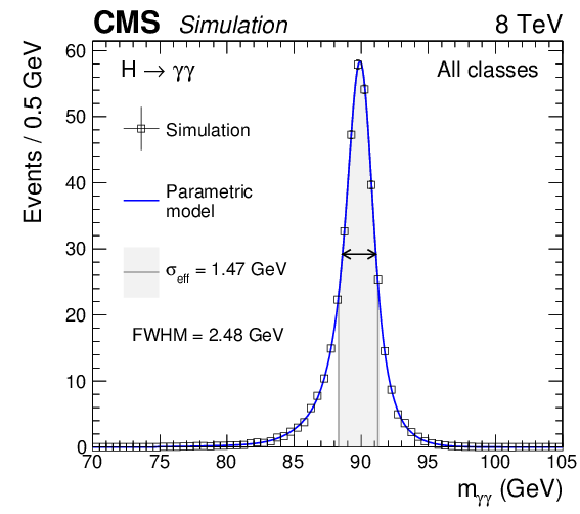
png pdf |
Figure 1-a:
Full parameterized signal shape, integrated over all event classes, in simulated signal events with $ {m_{\mathrm {H}}} = $ 90 GeV at $\sqrt {s} = $ 8 TeV. The open points are the weighted MC events and the blue lines the corresponding parametric models. Also shown are the $\sigma _{\text {eff}}$ values and the shaded region limited by $\pm \sigma _{\text {eff}}$, along with the FWHM values, indicated by the position of the arrows on each distribution. |
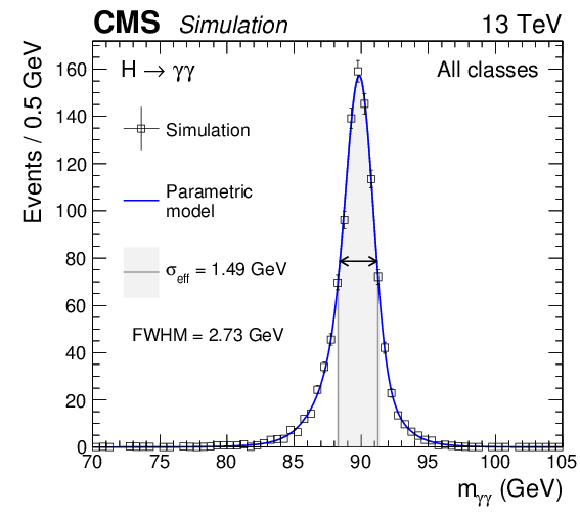
png pdf |
Figure 1-b:
Full parameterized signal shape, integrated over all event classes, in simulated signal events with $ {m_{\mathrm {H}}} = $ 90 GeV at $\sqrt {s} = $ 13 TeV. The open points are the weighted MC events and the blue lines the corresponding parametric models. Also shown are the $\sigma _{\text {eff}}$ values and the shaded region limited by $\pm \sigma _{\text {eff}}$, along with the FWHM values, indicated by the position of the arrows on each distribution. |

png pdf |
Figure 2:
Background model fits using the chosen "best-fit" parametrization to data in the four event classes at $\sqrt {s} = $ 8 TeV. The corresponding signal model for each class for $ {m_{\mathrm {H}}} = $ 90 GeV, multiplied by 10, is also shown. The one- and two-$\sigma $ bands reflect the uncertainty in the background model normalization associated with the statistical uncertainties of the fits, and are shown for illustration purposes only. The difference between the data and the best-fit model is shown in the lower panels. |
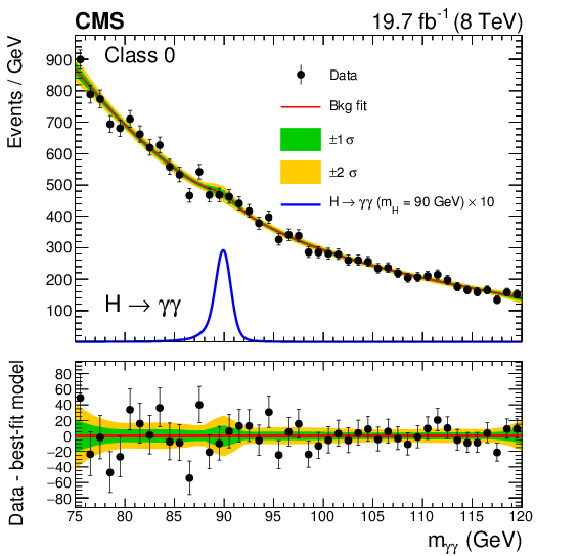
png pdf |
Figure 2-a:
Background model fits using the chosen "best-fit" parametrization to data in class 0 at $\sqrt {s} = $ 8 TeV. The corresponding signal model for $ {m_{\mathrm {H}}} = $ 90 GeV, multiplied by 10, is also shown. The one- and two-$\sigma $ bands reflect the uncertainty in the background model normalization associated with the statistical uncertainties of the fits, and are shown for illustration purposes only. The difference between the data and the best-fit model is shown in the lower panels. |

png pdf |
Figure 2-b:
Background model fits using the chosen "best-fit" parametrization to data in class 1 at $\sqrt {s} = $ 8 TeV. The corresponding signal model for $ {m_{\mathrm {H}}} = $ 90 GeV, multiplied by 10, is also shown. The one- and two-$\sigma $ bands reflect the uncertainty in the background model normalization associated with the statistical uncertainties of the fits, and are shown for illustration purposes only. The difference between the data and the best-fit model is shown in the lower panels. |

png pdf |
Figure 2-c:
Background model fits using the chosen "best-fit" parametrization to data in class 2 at $\sqrt {s} = $ 8 TeV. The corresponding signal model for $ {m_{\mathrm {H}}} = $ 90 GeV, multiplied by 10, is also shown. The one- and two-$\sigma $ bands reflect the uncertainty in the background model normalization associated with the statistical uncertainties of the fits, and are shown for illustration purposes only. The difference between the data and the best-fit model is shown in the lower panels. |
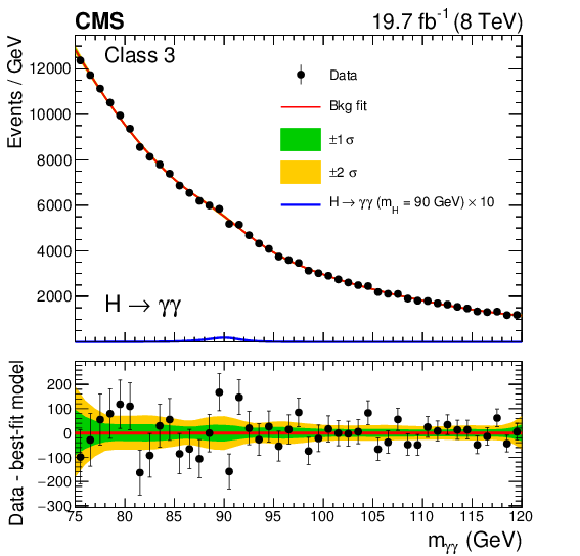
png pdf |
Figure 2-d:
Background model fits using the chosen "best-fit" parametrization to data in class 3 at $\sqrt {s} = $ 8 TeV. The corresponding signal model for $ {m_{\mathrm {H}}} = $ 90 GeV, multiplied by 10, is also shown. The one- and two-$\sigma $ bands reflect the uncertainty in the background model normalization associated with the statistical uncertainties of the fits, and are shown for illustration purposes only. The difference between the data and the best-fit model is shown in the lower panels. |

png pdf |
Figure 3:
Background model fits using the chosen "best-fit" parametrization to data in the three event classes at $\sqrt {s} = $ 13 TeV. The corresponding signal model for each class for $ {m_{\mathrm {H}}} = $ 90 GeV, multiplied by 10, is also shown. The one- and two-$\sigma $ bands reflect the uncertainty in the background model normalization associated with the statistical uncertainties of the fits, and are shown for illustration purposes only. The difference between the data and the best-fit model is shown in the lower panels. |
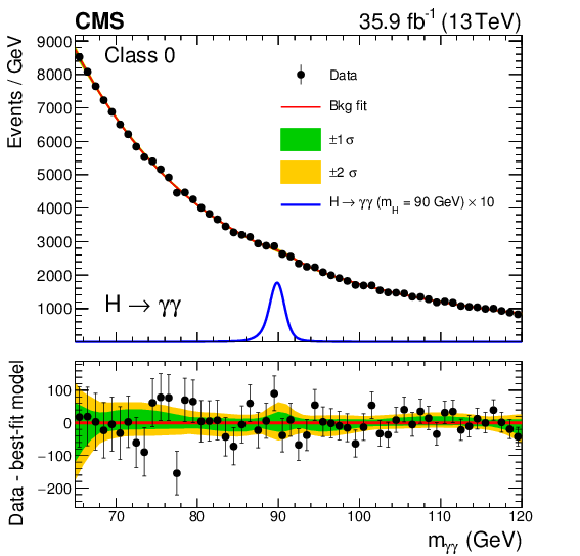
png pdf |
Figure 3-a:
Background model fits using the chosen "best-fit" parametrization to data in class 0 at $\sqrt {s} = $ 13 TeV. The corresponding signal model for $ {m_{\mathrm {H}}} = $ 90 GeV, multiplied by 10, is also shown. The one- and two-$\sigma $ bands reflect the uncertainty in the background model normalization associated with the statistical uncertainties of the fits, and are shown for illustration purposes only. The difference between the data and the best-fit model is shown in the lower panels. |
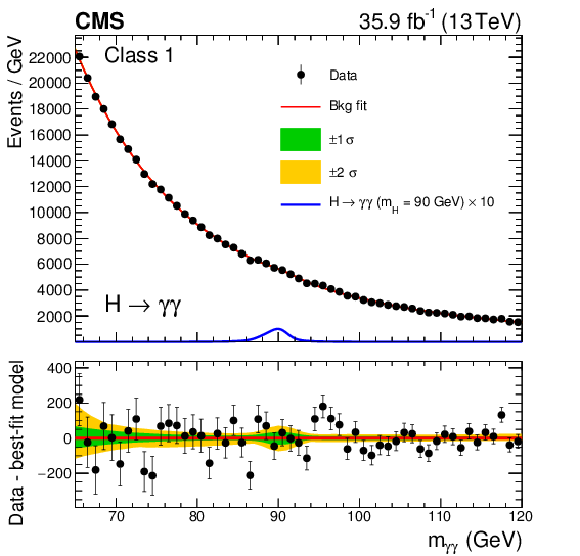
png pdf |
Figure 3-b:
Background model fits using the chosen "best-fit" parametrization to data in class 1 at $\sqrt {s} = $ 13 TeV. The corresponding signal model for $ {m_{\mathrm {H}}} = $ 90 GeV, multiplied by 10, is also shown. The one- and two-$\sigma $ bands reflect the uncertainty in the background model normalization associated with the statistical uncertainties of the fits, and are shown for illustration purposes only. The difference between the data and the best-fit model is shown in the lower panels. |
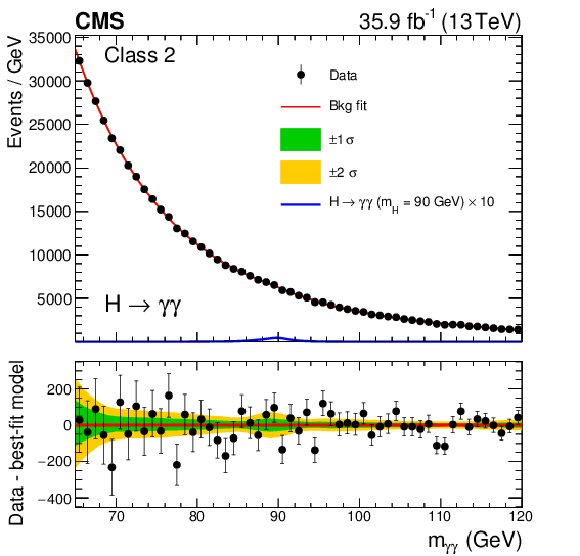
png pdf |
Figure 3-c:
Background model fits using the chosen "best-fit" parametrization to data in class 2 at $\sqrt {s} = $ 13 TeV. The corresponding signal model for $ {m_{\mathrm {H}}} = $ 90 GeV, multiplied by 10, is also shown. The one- and two-$\sigma $ bands reflect the uncertainty in the background model normalization associated with the statistical uncertainties of the fits, and are shown for illustration purposes only. The difference between the data and the best-fit model is shown in the lower panels. |

png pdf |
Figure 4:
Expected and observed exclusion limits (95% CL, in the asymptotic approximation) on the product of the production cross section and branching fraction into two photons for an additional SM-like Higgs boson, from the analysis of the 8 (left) and 13 (right) TeV data. The inner and outer bands indicate the regions containing the distribution of limits located within $\pm $1 and 2$\sigma $, respectively, of the expectation under the background-only hypothesis. The corresponding theoretical prediction for the product of the cross section and branching fraction into two photons for an additional SM-like Higgs boson is shown as a solid line with a hatched band, indicating its uncertainty [60]. |
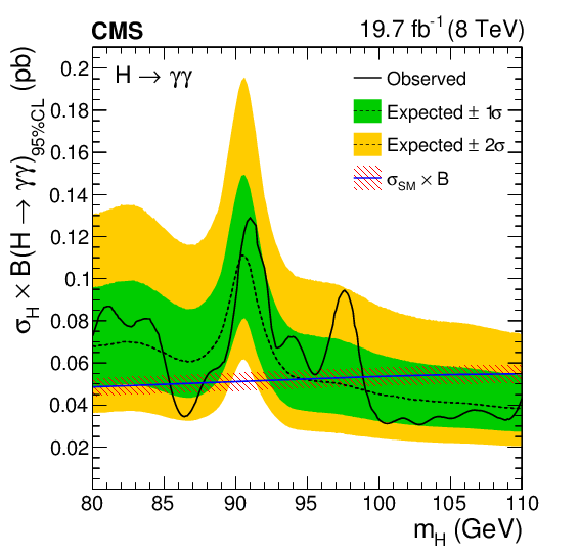
png pdf |
Figure 4-a:
Expected and observed exclusion limits (95% CL, in the asymptotic approximation) on the product of the production cross section and branching fraction into two photons for an additional SM-like Higgs boson, from the analysis of the 8 TeV data. The inner and outer bands indicate the regions containing the distribution of limits located within $\pm $1 and 2$\sigma $, respectively, of the expectation under the background-only hypothesis. The corresponding theoretical prediction for the product of the cross section and branching fraction into two photons for an additional SM-like Higgs boson is shown as a solid line with a hatched band, indicating its uncertainty [60]. |

png pdf |
Figure 4-b:
Expected and observed exclusion limits (95% CL, in the asymptotic approximation) on the product of the production cross section and branching fraction into two photons for an additional SM-like Higgs boson, from the analysis of the 13 TeV data. The inner and outer bands indicate the regions containing the distribution of limits located within $\pm $1 and 2$\sigma $, respectively, of the expectation under the background-only hypothesis. The corresponding theoretical prediction for the product of the cross section and branching fraction into two photons for an additional SM-like Higgs boson is shown as a solid line with a hatched band, indicating its uncertainty [60]. |

png pdf |
Figure 5:
Expected and observed exclusion limits (95% CL, in the asymptotic approximation) on the product of the production cross section and branching fraction into two photons for an additional SM-like Higgs boson, for the $ {\mathrm {g}} {\mathrm {g}} {\mathrm {H}} $ plus $ {{\mathrm {t}\overline {\mathrm {t}}}} {\mathrm {H}} $ (left) and VBF plus $\mathrm {V} {\mathrm {H}} $ (right) processes, from the analysis of the 8 (top) and 13 (bottom) TeV data. The inner and outer bands indicate the regions containing the distribution of limits located within $\pm $1 and 2$\sigma $, respectively, of the expectation under the background-only hypothesis. |
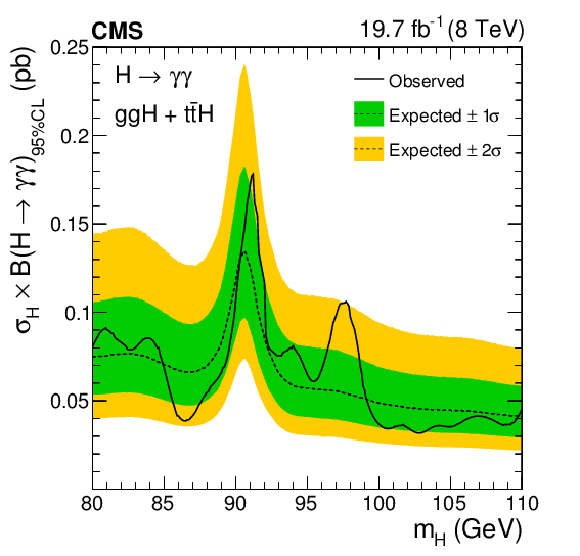
png pdf |
Figure 5-a:
Expected and observed exclusion limits (95% CL, in the asymptotic approximation) on the product of the production cross section and branching fraction into two photons for an additional SM-like Higgs boson, for the $ {\mathrm {g}} {\mathrm {g}} {\mathrm {H}} $ plus $ {{\mathrm {t}\overline {\mathrm {t}}}} {\mathrm {H}} $ processes, from the analysis of the 8 TeV data. The inner and outer bands indicate the regions containing the distribution of limits located within $\pm $1 and 2$\sigma $, respectively, of the expectation under the background-only hypothesis. |

png pdf |
Figure 5-b:
Expected and observed exclusion limits (95% CL, in the asymptotic approximation) on the product of the production cross section and branching fraction into two photons for an additional SM-like Higgs boson, for the VBF plus $\mathrm {V} {\mathrm {H}} $ processes, from the analysis of the 13 TeV data. The inner and outer bands indicate the regions containing the distribution of limits located within $\pm $1 and 2$\sigma $, respectively, of the expectation under the background-only hypothesis. |

png pdf |
Figure 5-c:
Expected and observed exclusion limits (95% CL, in the asymptotic approximation) on the product of the production cross section and branching fraction into two photons for an additional SM-like Higgs boson, for the $ {\mathrm {g}} {\mathrm {g}} {\mathrm {H}} $ plus $ {{\mathrm {t}\overline {\mathrm {t}}}} {\mathrm {H}} $ processes, from the analysis of the 8 TeV data. The inner and outer bands indicate the regions containing the distribution of limits located within $\pm $1 and 2$\sigma $, respectively, of the expectation under the background-only hypothesis. |
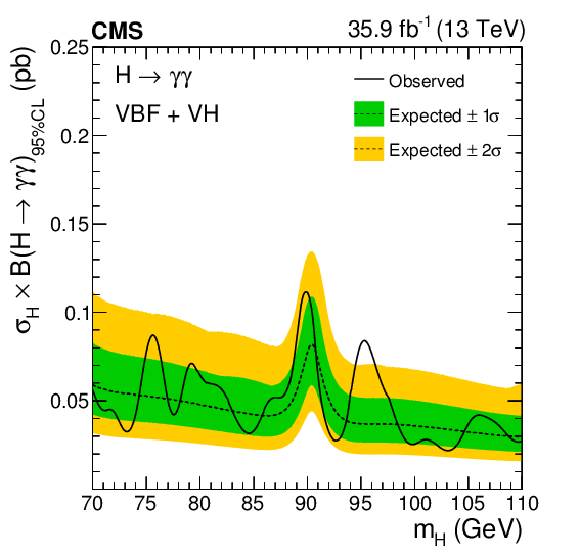
png pdf |
Figure 5-d:
Expected and observed exclusion limits (95% CL, in the asymptotic approximation) on the product of the production cross section and branching fraction into two photons for an additional SM-like Higgs boson, for the VBF plus $\mathrm {V} {\mathrm {H}} $ processes, from the analysis of the 13 TeV data. The inner and outer bands indicate the regions containing the distribution of limits located within $\pm $1 and 2$\sigma $, respectively, of the expectation under the background-only hypothesis. |
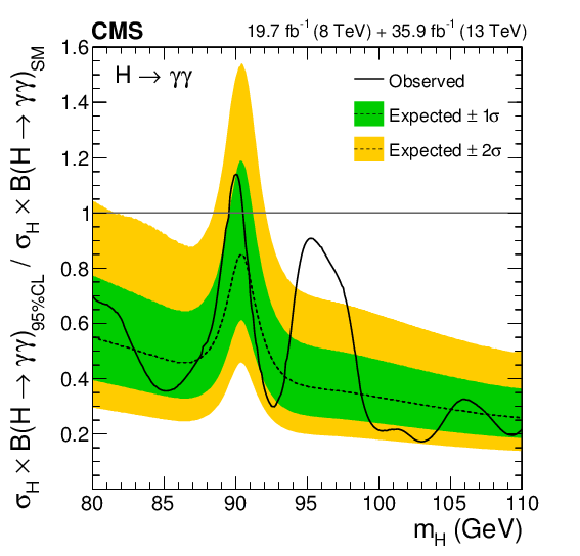
png pdf |
Figure 6:
Expected and observed exclusion limits (95% CL, in the asymptotic approximation) on the product of the production cross section and branching fraction into two photons for an additional Higgs boson, relative to the expected SM-like value, from the analysis of the 8 and 13 TeV data. The inner and outer bands indicate the regions containing the distribution of limits located within $\pm $1 and 2$\sigma $, respectively, of the expectation under the background-only hypothesis. |
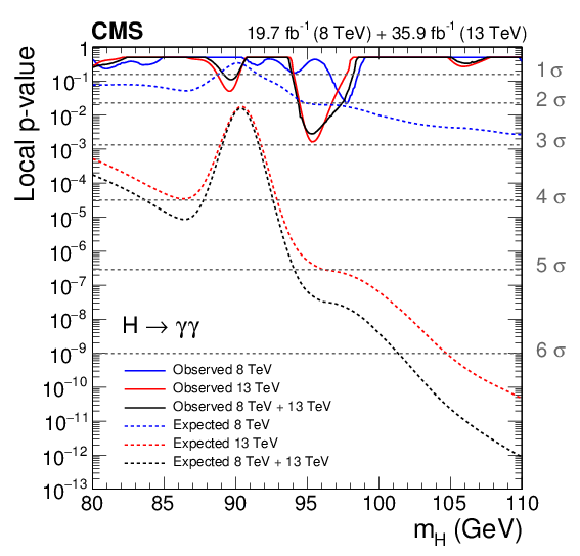
png pdf |
Figure 7:
Expected and observed local $p$-values as a function of $ {m_{\mathrm {H}}} $ for the 8 and 13 TeV data and their combination (solid curves) plotted together with the relevant expectations for an additional SM-like Higgs boson (dotted curves). |
| Tables | |

png pdf |
Table 1:
The expected number of SM-like Higgs boson signal events ($ {m_{\mathrm {H}}} = $ 90 GeV) per event class and the corresponding percentage breakdown per production process, for the 8 and 13 TeV data. The values of $\sigma _{\text {eff}}$ and $\sigma _{\text {HM}}$ are also shown, along with the number of background events ("Bkg.'') per GeV estimated from the background-only fit to the data, including the number from the Drell-Yan process ("DY Bkg.''), in a $\sigma _{\text {eff}}$ window centered on $ {m_{\mathrm {H}}} = $ 90 GeV. |
| Summary |
| A search for an additional, SM-like, low-mass Higgs boson decaying into two photons has been presented. It is based upon data samples corresponding to integrated luminosities of 19.7 and 35.9 fb$^{-1}$ collected at center-of-mass energies of 8 TeV in 2012 and 13 TeV in 2016, respectively. The search is performed in a mass range between 70 and 110 GeV. The expected and observed 95% CL upper limits on the product of the production cross section and branching fraction into two photons for an additional SM-like Higgs boson as well as the expected and observed local $p$-values are presented. No significant (${>}$3$\sigma$) excess with respect to the expected number of background events is observed. The observed upper limit on the product of the production cross section and branching fraction for the 2012 (2016) data set ranges from 129 (161) fb to 31 (26) fb. The statistical combination of the results from the analyses of the two data sets in the common mass range between 80 and 110 GeV yields an upper limit on the product of the cross section and branching fraction, normalized to that for a standard model-like Higgs boson, ranging from 0.7 to 0.2, with two notable exceptions: one in the region around the Z boson peak, where the limit rises to 1.1, caused by the presence of Drell-Yan dielectron production where both electrons are misidentified as isolated photons, and a second due to an observed excess with respect to the standard model prediction, which is maximal for a mass hypothesis of 95.3 GeV with a local (global) significance of 2.8 (1.3) standard deviations. More data are required to ascertain the origin of this excess. This is the first search for new resonances in the diphoton final state in this mass range based on LHC data at a center-of-mass energy of 13 TeV. |
| References | ||||
| 1 | S. L. Glashow | Partial-symmetries of weak interactions | NP 22 (1961) 579 | |
| 2 | S. Weinberg | A model of leptons | PRL 19 (1967) 1264 | |
| 3 | A. Salam | Weak and electromagnetic interactions | in Elementary particle physics: relativistic groups and analyticity, N. Svartholm, ed., p. 367 Almqvist \& Wiksell, Stockholm, 1968 Proceedings of the eighth Nobel symposium | |
| 4 | F. Englert and R. Brout | Broken symmetry and the mass of gauge vector mesons | PRL 13 (1964) 321 | |
| 5 | P. W. Higgs | Broken symmetries, massless particles and gauge fields | PL12 (1964) 132 | |
| 6 | P. W. Higgs | Broken symmetries and the masses of gauge bosons | PRL 13 (1964) 508 | |
| 7 | G. S. Guralnik, C. R. Hagen, and T. W. B. Kibble | Global conservation laws and massless particles | PRL 13 (1964) 585 | |
| 8 | P. W. Higgs | Spontaneous symmetry breakdown without massless bosons | PR145 (1966) 1156 | |
| 9 | T. W. B. Kibble | Symmetry breaking in non-Abelian gauge theories | PR155 (1967) 1554 | |
| 10 | ATLAS Collaboration | Observation of a new particle in the search for the standard model Higgs boson with the ATLAS detector at the LHC | PLB 716 (2012) 1 | 1207.7214 |
| 11 | CMS Collaboration | Observation of a new boson at a mass of 125 GeV with the CMS experiment at the LHC | PLB 716 (2012) 30 | CMS-HIG-12-028 1207.7235 |
| 12 | CMS Collaboration | Observation of a new boson with mass near 125 GeV in pp collisions at $ \sqrt{s} = $ 7 and 8 TeV | JHEP 06 (2013) 081 | CMS-HIG-12-036 1303.4571 |
| 13 | P. Fayet | Supergauge invariant extension of the Higgs mechanism and a model for the electron and its neutrino | NPB 90 (1975) 104 | |
| 14 | R. Barbieri, S. Ferrara, and C. A. Savoy | Gauge models with spontaneously broken local supersymmetry | PLB 119 (1982) 343 | |
| 15 | M. Dine, W. Fischler, and M. Srednicki | A simple solution to the strong CP problem with a harmless axion | PLB 104 (1981) 199 | |
| 16 | H. P. Nilles, M. Srednicki, and D. Wyler | Weak interaction breakdown induced by supergravity | PLB 120 (1983) 346 | |
| 17 | J. M. Fr\`ere, D. R. T. Jones, and S. Raby | Fermion masses and induction of the weak scale by supergravity | NPB 222 (1983) 11 | |
| 18 | J. P. Derendinger and C. A. Savoy | Quantum effects and SU(2) x U(1) breaking in supergravity gauge theories | NPB 237 (1984) 307 | |
| 19 | J. Ellis et al. | Higgs bosons in a nonminimal supersymmetric model | PRD 39 (1989) 844 | |
| 20 | M. Drees | Supersymmetric models with extended Higgs sector | Int. J. Mod. Phys. A 4 (1989) 3635 | |
| 21 | U. Ellwanger, M. Rausch de Traubenberg, and C. A. Savoy | Particle spectrum in supersymmetric models with a gauge singlet | PLB 315 (1993) 331 | hep-ph/9307322 |
| 22 | U. Ellwanger, M. Rausch de Traubenberg, and C. A. Savoy | Higgs phenomenology of the supersymmetric model with a gauge singlet | Z. Phys. C 67 (1995) 665 | hep-ph/9502206 |
| 23 | U. Ellwanger, M. Rausch de Traubenberg, and C. A. Savoy | Phenomenology of supersymmetric models with a singlet | NPB 492 (1997) 21 | hep-ph/9611251 |
| 24 | T. Elliott, S. F. King, and P. L. White | Unification constraints in the next-to-minimal supersymmetric standard model | PLB 351 (1995) 213 | hep-ph/9406303 |
| 25 | S. F. King and P. L. White | Resolving the constrained minimal and next-to-minimal supersymmetric standard models | PRD 52 (1995) 4183 | hep-ph/9505326 |
| 26 | F. Franke and H. Fraas | Neutralinos and Higgs bosons in the next-to-minimal supersymmetric standard model | Int. J. Mod. Phys. A 12 (1997) 479 | hep-ph/9512366 |
| 27 | M. Maniatis | The next-to-minimal supersymmetric extension of the standard model reviewed | Int. J. Mod. Phys. A 25 (2010) 3505 | 0906.0777 |
| 28 | U. Ellwanger, C. Hugonie, and A. M. Teixeira | The next-to-minimal supersymmetric standard model | PR 496 (2010) 1 | 0910.1785 |
| 29 | J.-W. Fan et al. | Study of diphoton decays of the lightest scalar Higgs boson in the next-to-minimal supersymmetric standard model | Chinese Physics C 38 (2014) 073101 | 1309.6394 |
| 30 | U. Ellwanger and M. Rodriguez-Vazquez | Discovery prospects of a light scalar in the NMSSM | JHEP 02 (2016) 096 | 1512.04281 |
| 31 | M. Guchait and J. Kumar | Diphoton signal of light pseudoscalar in NMSSM at the LHC | PRD 95 (2017) 035036 | 1608.05693 |
| 32 | J. Cao et al. | Diphoton signal of the light Higgs boson in natural NMSSM | PRD 95 (2017) 116001 | 1612.08522 |
| 33 | A. Celis, V. Ilisie, and A. Pich | LHC constraints on two-Higgs doublet models | JHEP 07 (2013) 053 | 1302.4022 |
| 34 | B. Coleppa, F. Kling, and S. Su | Constraining type II 2HDM in light of LHC Higgs searches | JHEP 01 (2014) 161 | 1305.0002 |
| 35 | S. Chang et al. | Two Higgs doublet models for the LHC Higgs boson data at $ \sqrt{s}= $ 7 and 8 TeV | JHEP 09 (2014) 101 | 1310.3374 |
| 36 | J. Bernon et al. | Scrutinizing the alignment limit in two-Higgs-doublet models. II. m$ _h = $ 125 GeV | PRD 93 (2016) 035027 | 1511.03682 |
| 37 | G. Cacciapaglia et al. | Search for a lighter Higgs boson in two Higgs doublet models | JHEP 12 (2016) 68 | 1607.08653 |
| 38 | ALEPH Collaboration, DELPHI Collaboration, L3 Collaboration, OPAL Collaboration and the LEP working group for Higgs boson searches | Search for the standard model Higgs boson at LEP | PLB 565 (2003) 61 | hep-ex/0306033 |
| 39 | ATLAS Collaboration | Search for scalar diphoton resonances in the mass range 65--600 GeV with the ATLAS detector in $ pp $ collision data at $ \sqrt{s}=8\text{}\text{}\mathrm{TeV} $ | PRL 113 (2014) 171801 | 1407.6583 |
| 40 | CMS Collaboration | Observation of the diphoton decay of the Higgs boson and measurement of its properties | EPJC 74 (2014) 3076 | CMS-HIG-13-001 1407.0558 |
| 41 | CMS Collaboration | Measurements of Higgs boson properties in the diphoton decay channel in proton-proton collisions at $ \sqrt{s} = $ 13 TeV | Accepted by \it JHEP | CMS-HIG-16-040 1804.02716 |
| 42 | CMS Collaboration | The CMS experiment at the CERN LHC | JINST 3 (2008) S08004 | CMS-00-001 |
| 43 | CMS Collaboration | Performance of photon reconstruction and identification with the CMS detector in proton-proton collisions at $ \sqrt{s}= $ 8 TeV | JINST 10 (2015) P08010 | CMS-EGM-14-001 1502.02702 |
| 44 | CMS Collaboration | The CMS trigger system | JINST 12 (2017) P01020 | CMS-TRG-12-001 1609.02366 |
| 45 | CMS Collaboration | Measurement of the inclusive $ W $ and $ Z $ production cross sections in $ pp $ collisions at $ \sqrt{s}= $ 7 TeV | JHEP 10 (2011) 132 | CMS-EWK-10-005 1107.4789 |
| 46 | P. Nason | A new method for combining NLO QCD with shower Monte Carlo algorithms | JHEP 11 (2004) 040 | hep-ph/0409146 |
| 47 | S. Frixione, P. Nason, and C. Oleari | Matching NLO QCD computations with parton shower simulations: the POWHEG method | JHEP 11 (2007) 070 | 0709.2092 |
| 48 | S. Alioli, P. Nason, C. Oleari, and E. Re | A general framework for implementing NLO calculations in shower Monte Carlo programs: the POWHEG BOX | JHEP 06 (2010) 043 | 1002.2581 |
| 49 | S. Alioli, P. Nason, C. Oleari, and E. Re | NLO Higgs boson production via gluon fusion matched with shower in POWHEG | JHEP 04 (2009) 002 | 0812.0578 |
| 50 | P. Nason and C. Oleari | NLO Higgs boson production via vector-boson fusion matched with shower in POWHEG | JHEP 02 (2010) 037 | 0911.5299 |
| 51 | T. Sjostrand, S. Mrenna, and P. Skands | PYTHIA 6.4 physics and manual | JHEP 05 (2006) 026 | hep-ph/0603175 |
| 52 | J. Alwall et al. | The automated computation of tree-level and next-to-leading order differential cross sections, and their matching to parton shower simulations | JHEP 07 (2014) 079 | 1405.0301 |
| 53 | R. Frederix and S. Frixione | Merging meets matching in MC@NLO | JHEP 12 (2012) 061 | 1209.6215 |
| 54 | J. Pumplin et al. | New generation of parton distributions with uncertainties from global QCD analysis | JHEP 07 (2002) 012 | hep-ph/0201195 |
| 55 | H.-L. Lai et al. | New parton distributions for collider physics | PRD 82 (2010) 074024 | 1007.2241 |
| 56 | NNPDF Collaboration | Parton distributions for the LHC run II | JHEP 04 (2015) 040 | 1410.8849 |
| 57 | T. Sjostrand, S. Mrenna, and P. Z. Skands | A brief introduction to PYTHIA 8.1 | CPC 178 (2008) 852 | 0710.3820 |
| 58 | CMS Collaboration | Study of the underlying event at forward rapidity in pp collisions at $ \sqrt{s} = $ 0.9, 2.76, and 7 TeV | JHEP 04 (2013) 072 | CMS-FWD-11-003 1302.2394 |
| 59 | CMS Collaboration | Event generator tunes obtained from underlying event and multiparton scattering measurements | EPJC 76 (2016) 155 | CMS-GEN-14-001 1512.00815 |
| 60 | LHC Higgs Cross Section Working Group | Handbook of LHC Higgs cross sections: 4. deciphering the nature of the Higgs sector | CERN (2016) | 1610.07922 |
| 61 | GEANT4 Collaboration | GEANT4--a simulation toolkit | NIMA 506 (2003) 250 | |
| 62 | T. Gleisberg et al. | Event generation with SHERPA 1.1 | JHEP 02 (2009) 007 | 0811.4622 |
| 63 | E. Re | NLO corrections merged with parton showers for Z+2 jets production using the POWHEG method | JHEP 10 (2012) 031 | 1204.5433 |
| 64 | CMS Collaboration | Particle-flow reconstruction and global event description with the CMS detector | JINST 12 (2017) P10003 | CMS-PRF-14-001 1706.04965 |
| 65 | CMS Collaboration | Energy calibration and resolution of the CMS electromagnetic calorimeter in pp collisions at $ \sqrt{s} = $ 7 TeV | JINST 8 (2013) P09009 | CMS-EGM-11-001 1306.2016 |
| 66 | P. D. Dauncey, M. Kenzie, N. Wardle, and G. J. Davies | Handling uncertainties in background shapes: the discrete profiling method | JINST 10 (2015) P04015 | 1408.6865 |
| 67 | M. J. Oreglia | A study of the reactions $\psi' \to \gamma\gamma \psi$ | PhD thesis, Stanford University, 1980 SLAC Report SLAC-R-236, see A | |
| 68 | R. A. Fisher | On the interpretation of $ \chi^{2} $ from contingency tables, and the calculation of p | J. Royal Stat. Soc 85 (1922) 87 | |
| 69 | CMS Collaboration | CMS luminosity based on pixel cluster counting - Summer 2013 update | CMS-PAS-LUM-13-001 | CMS-PAS-LUM-13-001 |
| 70 | CMS Collaboration | CMS luminosity measurements for the 2016 data taking period | CMS-PAS-LUM-17-001 | CMS-PAS-LUM-17-001 |
| 71 | S. Carrazza et al. | An unbiased Hessian representation for Monte Carlo PDFs | EPJC 75 (2015) 369 | 1505.06736 |
| 72 | J. Butterworth et al. | PDF4LHC recommendations for LHC Run II | JPG 43 (2016) 023001 | 1510.03865 |
| 73 | ATLAS and CMS Collaborations, LHC Higgs Combination Group | Procedure for the LHC Higgs boson search combination in Summer 2011 | CMS-NOTE-2011-005 | |
| 74 | T. Junk | Confidence level computation for combining searches with small statistics | NIMA 434 (1999) 435 | hep-ex/9902006 |
| 75 | A. L. Read | Presentation of search results: The CL(s) technique | JPG 28 (2002) 2693 | |
| 76 | G. Cowan, K. Cranmer, E. Gross, and O. Vitells | Asymptotic formulae for likelihood-based tests of new physics | EPJC 71 (2011) 1554 | 1007.1727 |
| 77 | E. Gross and O. Vitells | Trial factors for the look elsewhere effect in high energy physics | EPJC 70 (2010) 525 | 1005.1891 |

|
Compact Muon Solenoid LHC, CERN |

|

|

|

|

|

|